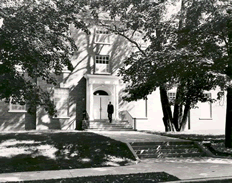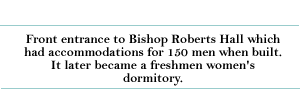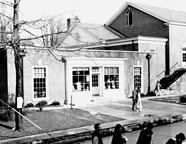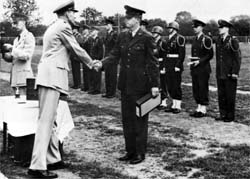
Pages:
<< Back 1
2 3
4 5
6 7
8 9 10
Next >>
One
of President Humbert's first major steps was to initiate the Greater
DePauw Program, a 10-to-15 year plan to raise $10 million, about
half for new buildings and half for endowment. Marts and Lundy,
a consulting firm of which Humbert's father-in-law, George Lundy,
was vice president, surveyed the needs of the university and possible
sources of financial support. Upon the firm's recommendation the
first phase of the program was set in motion, a campaign to raise
$1 million for a new library and $500,000 for other purposes, including
faculty salaries. Willard Umbreit was transferred from the admissions
office to direct the program. He was assisted by Orville Davis,
who was named director of church relations, along with representatives
of Marts and Lundy. By 1954 the campaign had collected $1,671,000
including a challenge grant of $150,000 from the Lilly Endowment.
Approximately one-third of the alumni and former students solicited
made contributions.

A
building committee chaired by the librarian, Vera S. Cooper, began
drawing up plans for the construction of a large modern library
on the site of the former West College. Two specialists in library
architecture, Joseph L. Wheeler and J. Russell Bailey, were called
in to assist in planning a facility meeting both present and future
needs of the university.
The resulting structure, designed principally by Bailey, a Virginia
architect, departed radically from the Colonial lines of Asbury
and Harrison Halls with which it formed an academic quadrangle.
Cost considerations largely dictated its construction as a box-like,
flat-roofed cube of reinforced concrete and brick. Named for distinguished
alumnus and trustee Roy O. West and opened for use in 1956, the
building provided sufficient space for the first time to house the
university's library holdings and technical services.
 
The abandoned Carnegie Library was then made into the University
Art Center, with considerable remodeling financed by contributions
from alumni and friends of DePauw, and dedicated on Old Gold Day
1958. A new entrance with a large double stairway was added on the
south side of the building, with its four great Ionic stone columns.
Inside the former reading room of the library was converted into
a spacious gallery for art exhibits, while the basement and upper
floor furnished quarters for art studios, classrooms, a small theatre,
and faculty offices. At the same time the university purchased the
two-story frame building across College Avenue that had long served
as a campus hang-out and remodeled it as an air-conditioned office
building for members of the humanities and social sciences faculty.
The second phase of the Greater DePauw Program began in 1958 with
another survey by Marts and Lundy. At the urging of President Humbert
the goal was raised to $2 million. Led by Humbert himself, Norman
Knights, the newly named director of public relations and financial
promotion, and Robert Crouch, the secretary of alumni affairs, with
Marts and Lundy, the campaign raised slightly more than the targeted
amount by June 1961.
Just before it was completed the trustees authorized the construction
of a new men's dormitory to replace antiquated Florence Hall. Constructed
at a cost of $850,000 and designed by the same architectural firm,
McGuire and Shook, that had drawn the plans for the Student Union,
this was to be the last campus building to follow the Georgian Colonial
pattern. It was named for the pioneer Indiana Methodist bishop,
Robert E. Roberts, and opened for occupancy in the fall of 1961.
Bishop Roberts Hall furnished living quarters for 150 men - later
women - and dining facilities connected through a tunnel to the
kitchen in nearby Longden Hall. The subsequent razing of Florence
Hall left East College, Music Hall, and McKim Observatory as the
only surviving 19th century structures on campus.

In academic matters President Humbert proceeded cautiously, perhaps
in recognition of his inexperience in this area, and tended to rely
heavily on the advice and guidance of senior faculty and administrative
staff. To replace Dean Norris, who resigned in 1952 to accept the
presidency of MacMurray College, he chose Robert Farber from the
dean of student's office. Farber, who spent most of his adult life
in various administrative posts at DePauw, was to serve as academic
dean longer than anyone before or since. In 1952 DePauw alumnus
John J. Wittich was named director of admissions and the Rector
Scholarship Foundation, and another alumnus, Donald L. Tourtelot,
was named the first full-time director of publicity and the news
bureau.

The
new position of dean of chapels was created to organize the weekly
chapel and convocation programs, a task assumed by veteran Professor
of English Jerome Hixson in addition to
his teaching duties. In 1954, when a bookstore was added to the
Student Union Building, Samuel T. Hanna was persuaded to become
its first manager. The jovial "Sam" Hanna, a DePauw graduate
who had operated his own bookstore downtown for many years, made
the university's entrance into the book business a success from
the start.
 
Other
administrative shifts included the appointment of David W. Robinson
as assistant dean of students in 1952, followed by William McK.
Wright in 1957. Ethel A. Mitchell moved from the physical education
department in 1960 to take the place of Lucille Scheuer with the
new title of associate dean of students. Upon the death of Veneta
Kunter in 1952 her assistant, alumna Value Timmons Williams, became
registrar. Successive directors of the Memorial Student Union Building
were Glenn W. Timmons in 1952 and John Nanovsky in 1956. DePauw
graduate James N. Cook was named editor of the DePauw Alumnus in
1954 and also acted as assistant secretary of alumni affairs. In
1961 Louis J. Fontaine succeeded fellow DePauw alumnus Wittich as
director of admissions.
 __________________________________ __________________________________
Air Force ROTC ceremony
in 1955. Captain
Joseph Campbell is at the microphone and
Lt. Colonel Frederick Sanders presents the
award to Eugene N. Holladay '57.
_______________________________________
Worth M. Tippy, a retired Methodist minister who had graduated from
DePauw in 1891, was responsible for establishing the Archives of
DePauw University and Indiana Methodism in two small rooms in the
basement of the Administration Building in 1951. Tippy, who was
named the first archivist, had studied archival procedures in Washington,
D.C. and began collecting the large quantity of documents which
are now stored in specially equipped rooms in the Roy O. West Library.
He also played an important role in the removal of Old Bethel Church
from Charlestown, Indiana where it had been built in 1807, to the
grounds of Gobin Memorial Methodist Church. The log structure, the
first Methodist church building in Indiana, was dedicated on Founders'
and Benefactors' Day in 1955. It stands there today as a tangible
reminder of DePauw's Methodist origins.
Back
to Top
Pages:
<< Back 1
2 3
4 5
6 7
8 9 10
Next >>
|











 __________________________________
__________________________________